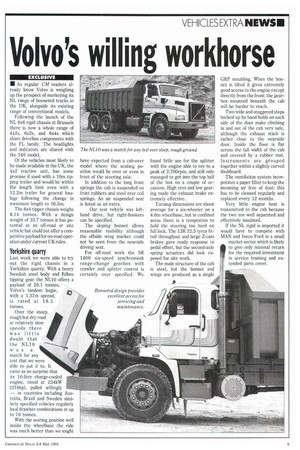Volvo's willing workhorse
Page 11

If you've noticed an error in this article please click here to report it so we can fix it.
EXCLUSIVE
• As regular CM readers already know Volvo is weighing up the prospect of marketing its NL range of bonneted trucks in the UK, alongside its existing range of conventional models.
Following the launch of the NL 6x6 rigid chassis at Brussels there is now a whole range of 4x2s, 6x2s, and 6x4s which share driveline components with the FL family. The headlights and indicators are shared with the 240 model.
Of the vehicles most likely to be made available in the UK, the 4x2 tractive unit, has some promise if used with a 10m tipping trailer and would be within the length limit even with a 12.2m trailer for general haulage following the change in maximum length to 16.5m.
The 6x4 tipper chassis weighs 8.14 tonnes. With a design weight of 32.7 tonnes it has potential as an off-road or site vehicle but could not offer a competitive payload for on-road operation under current UK rules.
Yorkshire quarry
Last week we were able to try out the rigid chassis in a Yorkshire quarry. With a heavy Swedish steel body and Edbro tipping gear the NL10 offers a payload of 20.1 tonnes.
Volvo's tandem bogie, si with a 1.37m spread, is rated at 18.5 tonnes.
Over the steep, rough but dry road at relatively slow speeds there was little doubt that the NL10 was a match for any test that we were able to put it to. It came as no surprise that its 10-litre charge-cooled engine, rated at 234kW (318hp), pulled willingly — in countries including Australia, Brazil and Sweden similarly specified vehicles regularly haul drawbar combinations at up to 70 tonnes.
With the seating position well inside the wheelbase the ride was much better than we might have expected from a cab-over model where the seating position would be over or even in front of the steering axle.
In addition to the long front springs the cab is suspended on front rubbers and steel rear coil springs. An air suspended seat is listed as an extra.
Our test vehicle was lefthand drive, but right-hookers can be specified.
The sloping bonnet allows reasonable visibility although the offside wing marker could not be seen from the nearside driving seat.
For off-road work the SR 1400 six-speed synchromesh range-change gearbox with crawler and splitter control is certainly over specified. We found little use for the splitter with the engine able to rev to a peak of 2,700rpm, and still only managed to get into the top half of the box on a couple of occasions, High revs and low gearing made the exhaust brake extremely effective.
Turning dimensions are about average for a six-wheeler on a 4.6m wheelbase, but in confined areas there is a temptation to hold the steering too hard on full lock. The 13R 22.5 tyres fitted throughout and large Z-cam brakes gave ready response to pedal effort, but the second-axle spring actuators did look exposed for site work.
The main structure of the cab is steel, but the bonnet and wings are produced as a single GRP moulding. When the bonnet is tilted it gives extremely good access to the engine except directly from the front: the gearbox mounted beneath the cab will be harder to reach.
Two wide and staggered steps backed up by hand holds on each side of the door make climbing in and out of the cab very safe, although the exhaust stack is rather close to the nearside door. Inside the floor is flat across the full width of the cab and covered by a rubber mat. Instruments are grouped together within a slightly curved dashboard.
The ventilation system incorporates a paper filter to keep the incoming air free of dust; this has to be cleaned regularly and replaced every 12 months.
Very little engine heat is transmitted to the cab because the two are well separated and effectively insulated.
If the NL rigid is imported it would have to compete with MAN and lveco Ford in a small market sector which is likely to give only minimal return for the required investment in service training and extended parts cover.




















































































